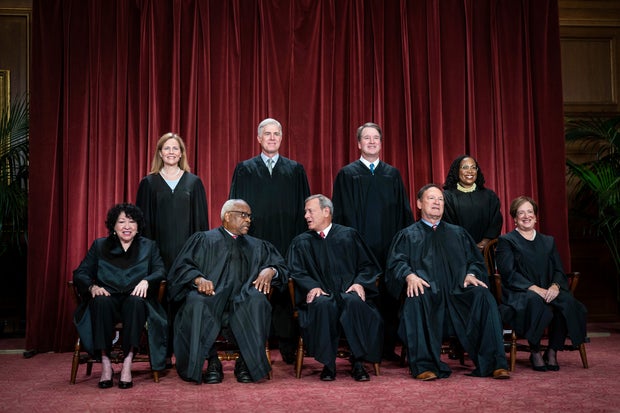Supreme Court limits federal regulatory power
Washington — In a blockbuster decision Friday, the Supreme Court overruled a 40-year-old decision that directed federal courts to defer to agencies’ interpretation of unclear laws enacted by Congress.
The landmark ruling from the court, which divided 6-3 along ideological lines, curtails the regulatory power of federal agencies and is expected to restrict the government’s ability to impose regulations on areas like the environment, health care and the workplace.
The decision marks a major victory for the conservative legal movement, which has long called for dismantling the framework that arose out of the 1984 ruling in a case known as Chevron v. National Resources Defense Council.
The justices did just that with their ruling in a pair of cases involving a 2020 federal regulation that required owners of vessels in the Atlantic herring fishery to pay for monitors while they’re at sea.
Here is why the decision in those two cases is so significant:
What is Chevron deference?

The concept of Chevron deference was borne out of the 1984 decision, which involved a challenge to a regulation enacted by the Environmental Protection Agency under the Clean Air Act that defined “stationary sources” of air pollution.
In that case from four decades ago, the Supreme Court used a two-step approach to uphold the EPA’s definition. The first step was to decide whether Congress had directly spoken to the question at hand. If Congress’ intent was clear, that marked the end of the analysis. But if not, and the statute was ambiguous as to the issue, the second step said courts should defer to the agency’s interpretation of the statute if it is reasonable.
That two-step test was referred to as Chevron deference. In practice, it has given broad leeway to federal agencies and government regulators to interpret laws when there is some dispute over what the text of the statute means. Lower courts have applied Chevron in thousands of cases, and the Supreme Court itself has upheld an agency’s reasonable interpretation of an ambiguous statute at least 70 times. But the high court has not applied Chevron doctrine since 2016.
What did the Supreme Court do?
The Supreme Court issued its ruling in two cases, Loper Bright Enterprises v. Raimondo and Relentless v. Department of Commerce, on Friday that explicitly overruled Chevron. Justice Ketanji Brown Jackson did not participate in the first case.
In its decision, the court held that a federal law known as the Administrative Procedure Act, or the APA, requires courts to exercise their own independent judgment when deciding whether an agency acted within its authority under the law. Courts, the majority found, should not defer to an agency’s interpretation of a law just because it is unclear.
Writing for the majority, Roberts said Chevron was a “judicial invention that required judges to disregard their statutory duties.”
When a court considers whether an agency has acted within its authority, the chief justice wrote, the judgment of the executive branch may help inform its analysis. And when a law assigns authority to an agency within constitutional limits, courts have to respect that delegation, the Supreme Court found.
But “courts need not and under the APA may not defer to an agency interpretation of the law simply because a statute is ambiguous,” the majority concluded.
Acknowledging that lower courts have long applied Chevron, Roberts said jettisoning the doctrine does not call into question those earlier decisions.
What will the ruling affect and why does it matter?
Supporters of Chevron deference have been sounding the alarm that a reversal of the 1984 ruling would hinder the ability of federal agencies to impose regulations that fill gaps in the laws passed by Congress. The Biden administration called Chevron a “bedrock principle of administrative law” that gave weight to the expertise of federal agencies and warned its reversal would create an “upheaval.”
Already, legal scholars who disagree with the Supreme Court’s decision to overturn Chevron have warned it concentrates power in the courts, leaving judges to make calls about policy that had previously been decided by experts who have deep experience in the subject area.
As Justice Elena Kagan put it in her dissenting opinion, “In one fell swoop, the majority today gives itself exclusive power over every open issue — no matter how expertise-driven or policy-laden — involving the meaning of regulatory law. As if it did not have enough on its plate, the majority turns itself into the country’s administrative czar.”
Joined by Justices Sonia Sotomayor and Jackson, Kagan said that by doing away with Chevron, courts will be at the center of the administrative process as to an array of subjects since there are always gaps in the law.
Among those, Kagan wrote: “What actions can be taken to address climate change or other environmental challenges? What will the nation’s health-care system look like in the coming decades? Or the financial or transportation systems? What rules are going to constrain the development of A.I.?”
What comes next?
Roberts wrote for the court that earlier decisions that relied on the Chevron framework will not be impacted by its reversal, but Kagan and the other two dissenters still said the ruling will be “disruptive” since it raises new doubts about agency actions that interpret statutes.
She warned that longstanding agency interpretations that had never challenged under Chevron may now be at the center of legal battles.
Some legal scholars are already bracing for a flood of litigation against agencies like the FDA and are warning that getting rid of Chevron deference will impact how government departments administer federal programs that serve broad swaths of the population.
Melissa Quinn is a politics reporter for CBSNews.com. She has written for outlets including the Washington Examiner, Daily Signal and Alexandria Times. Melissa covers U.S. politics, with a focus on the Supreme Court and federal courts.


